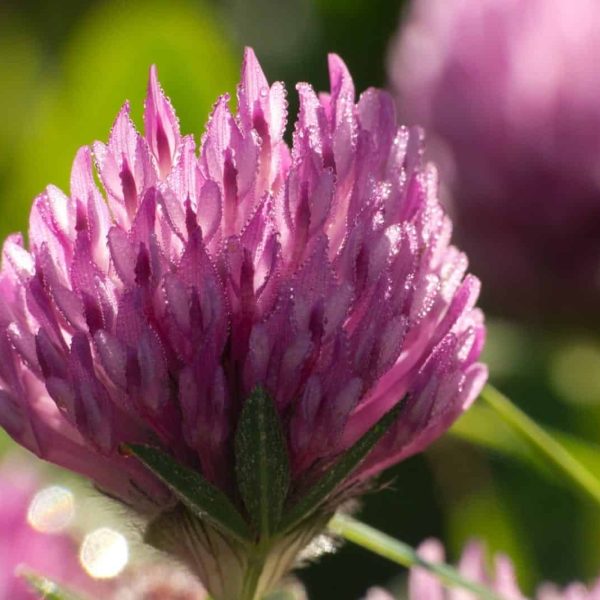-
How does it feel?
Red clover is a perennial plant that grows to heights of between 5-40cm. It has branching stems and the leaves are typical of the clover species. The flowers are a distinctive pinky red and consist of oval bunches of tiny individual trumpet-shaped flowers. It is native to Europe, Asia and Africa, but grows naturally throughout the UK. Red clover is widely distributed and common in meadows from May through to October.
-
What can I use it for?
Red clover contains a constituent known as isoflavone which has a similar structure to oestrogen. These constituents are classed as phyto-oestrogens and can be used to balance oestrogen levels in women. Despite common perceptions about phyto-oestrogens, they have a balancing effect upon endogenous oestrogen, to which their structure is very similar. Where endogenous oestrogen is low, phyto-oestrogens mimic oestrogen and take up vacant receptor sites in the body influencing a low-oestrogenic effect. Where oestrogen levels are high, phyto-oestrogens block receptor sites, lowering the effect of endogenous oestrogen on the body.
-
Into the heart of red clover
 A large proportion of research into the medicinal effects of red clover are centered around its phyto-oestrogenic properties and its benefits for treating hormone based conditions and supporting women through the hormonal changes that take place during adolescence, the menstrual cycle and also the menopause.
A large proportion of research into the medicinal effects of red clover are centered around its phyto-oestrogenic properties and its benefits for treating hormone based conditions and supporting women through the hormonal changes that take place during adolescence, the menstrual cycle and also the menopause.In addition to its hormone balancing effects, red clover is also classed as a blood tonic with a cleansing action upon the skin; it is of particular use where skin conditions are influenced by hormonal imbalance.
Red clover has also demonstrated expectorant and anti-spasmodic properties which has made it effective in the treatment of spasmodic coughs and excessive mucous congestion within the respiratory tract.
Indicated in female hormonal imbalance, particularly associated with oestrogen levels. Supportive for women during adolescence, the menstrual cycle and menopause.
Indicated in hormonal based skin conditions, including teenage acne. Also indicated in eczema, psoriasis and adult acne.
Red clover has an expectorant and anti-spasmodic effect, indicating it in spasmodic coughs, whooping cough and conditions where there is excessive mucous congestion within the respiratory tract.
-
Traditional actions
Herbal actions describe therapeutic changes that occur in the body in response to taking a herb. These actions are used to express how a herb physiologically influences cells, tissues, organs or systems. Clinical observations are traditionally what have defined these actions: an increase in urine output, diuretic; improved wound healing, vulnerary; or a reduction in fever, antipyretic. These descriptors too have become a means to group herbs by their effects on the body — herbs with a nervine action have become the nervines, herbs with a bitter action are the bitters. Recognising herbs as members of these groups provides a preliminary familiarity with their mechanisms from which to then develop an understanding of their affinities and nuance and discern their clinical significance.
-
Traditional energetic actions
Herbal energetics are the descriptions Herbalists have given to plants, mushrooms, lichens, foods, and some minerals based on the direct experience of how they taste, feel, and work in the body. All traditional health systems use these principles to explain how the environment we live in and absorb, impacts our health. Find out more about traditional energetic actions in our article “An introduction to herbal energetics“.
Western energetics
-
Did you know?
The blossoms were traditionally eaten to help with the symptoms of hayfever. If you pluck the blossom from the plant, when chewed, it produces a sweet nectar that was also often added to wine to impart a sweet flavor and pink colour.
Additional information
-
Safety
Caution with anticoagulants, salicylates and warfarin
-
Dosage
Tincture: 2-4ml three times daily (1:5. 40%).
Dried: 1-3 teaspoons of dried herb per cup of boiling water.
External uses: Apply fresh crushed flowers to bites & stings; diluted tincture as eyewash for conjunctivitis. Infusion as douche for vaginal infections, lotion for sore, inflamed skin & nipples, gargle for sore throats.



























 A large proportion of research into the medicinal effects of red clover are centered around its phyto-oestrogenic properties and its benefits for treating hormone based conditions and supporting women through the hormonal changes that take place during adolescence, the menstrual cycle and also the menopause.
A large proportion of research into the medicinal effects of red clover are centered around its phyto-oestrogenic properties and its benefits for treating hormone based conditions and supporting women through the hormonal changes that take place during adolescence, the menstrual cycle and also the menopause.




